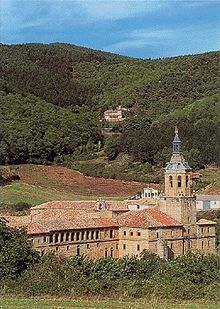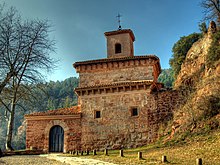San Millán de la Cogolla Monastery
| Monasteries of San Millán de Yuso and de Suso | |
|---|---|
|
UNESCO world heritage |
|

|
|
| San Millán de la Cogolla monastery, upper and lower monastery |
|
| National territory: |
|
| Type: | Culture |
| Criteria : | ii, iv, vi |
| Surface: | 19 ha |
| Reference No .: | 805 |
| UNESCO region : | Europe and North America |
| History of enrollment | |
| Enrollment: | 1997 (session 21) |
The Monastery of San Millán de la Cogolla ( Spanish : Monasterio de San Millán de la Cogolla ) is an ensemble consisting of the monasteries of San Millán de Yuso and San Millán de Suso . It is located on the left bank of the Cárdenas in the town of San Millán de la Cogolla , La Rioja , Spain . San Millán de Suso ( suso, from Latin: sursum = above ) lies above the San Millán de Yuso ( yuso, from Latin: deorsum = below ) built in the valley . Both monasteries were declared a World Heritage Site by UNESCO in 1997 because of their importance . The surviving monastic community there belongs to the Order of the Augustinian .
history
The starting point for the development was a hermit community, which the eponymous saint Aemilianus of Cogolla ( San Millán in Spanish ) had gathered around himself and his hermitage after his retreat to the Sierra de la Demanda . After his death, the tomb became a place of worship over which the first buildings of the upper monastery were erected in the 6th century. The changeover from the original ancestry to monastic life according to Benedictine rule required several extensions, for example a meeting room for the community was needed. These were made into the 12th century and have Visigoth , Mozarabic and Romanesque features according to their time . An important step was the foundation of the church and a first monastery by King Sancho II. Garcés of Navarre .
In 1001 this monastery was destroyed during a Moorish campaign under Al-Mansur .
Thereupon was 1053 on the orders of the Navarrischen King García III. Sánchez built the lower monastery and transferred the bones of St. Aemilianus, originally resting in San Millán de Suso, there.
The legend shows the processes involved in the overpass and the construction of the new monastery as follows:
King García III. Sánchez was very devoted to Saint Aemilianus. Since he had just founded the monastery of Santa María la Real de Nájera in his capital Nájera , he wanted to transfer its bones, which were resting in San Millán de Suso, to Nájera. The remains of the saint were loaded onto an ox cart and taken away. As they neared the river, the ox stopped and refused to move on. The king took this as a sign and had a new monastery built.
For the longest time in its history, the monastery was a Benedictine abbey . Augustinians have lived here since 1878 , not only maintaining monastic life, but also doing their best to preserve the buildings.
Buildings and art treasures
San Millan de Suso
The church with Visigoth , Mozarabic and Romanesque style elements exists from the upper monastery . The ships of almost the same size with a vestibule were built on the rocks above the cave in which Aemilianus and his students lived. Of these, the southern ship was built in 574 and the northern one in 984. The horseshoe-shaped triumphal arch, the twin column and the six-part choir dome are Visigoth style elements, the ribbed vault and an originally Visigothic capital , revised in the 10th century, reflect Mozarabic influences. The reconstruction after the destruction at the beginning of the 11th century was carried out in Romanesque style.
At the former burial site of San Millán there is still the sarcophagus from the 11th century with reliefs and a reclining representation of the saint. In the vestibule are the sarcophagi with the remains of Navarre queens and the infants of Lara, along with those of their tutor Nuño Salido.
San Millan de Yuso
The building was built in the Romanesque style that was common at the time . There were renovations after the 16th century, in the desornamentado style , the 17th and 18th centuries. One enters its interior through a baroque portal with Corinthian columns and a relief of the riding San Millán from the 17th century. The vestibule leads to the Salón de los Reyes (Salon of the Kings), where there are valuable paintings of counts and kings made by Brother Juan Rizzi . Among them García Sanchez III. and his father Sancho III. Garcés of Navarre. The latter has a special feature; his head is that of the Spanish writer Lope de Vega . The church has three naves, a crypt and a dome. The altarpiece dates from the 17th century, its central picture shows San Millán at the Battle of Hacinas . In the sacristy the relics of Saint Millán and his master Felix are kept in two silver boxes with ivory fittings. The San Millán casket was commissioned by King Sancho IV. Garcés in 1067. The monastery also has an important library that was built in 1665. She keeps some valuable codes and incunabula .
Worldly relevance
The Monastery of San Millán de la Cogolla is important not only from an artistic and monastic perspective , but also from a linguistic and literary point of view. Here a monk wrote the Glosas Emilianenses , the first text in West Aragonese (or Navarro-Aragonese), an Ibero-Romance language that originated from Vulgar Latin and is related to Spanish. They also contain the first notes in Basque . For this reason, the monastery is also considered the cradle of Spanish and Basque romances . In addition, the monk Gonzalo de Berceo , the first known poet of the new popular language Castilian, lived and worked here in the 12th and 13th centuries . The monastery library contains around 10,000 volumes.
See also
literature
- Míllan Bravo Lozano: Practical pilgrim guide. The Camino de Santiago. Editorial Everest, Léon 1994, ISBN 84-241-3835-X .
- Werner Schäfke : Nordwestspanien , Dumont Buchverlag, Cologne, 3rd edition 1989, ISBN 3-7701-1589-9 .
- Heinz Schomann: Art Monuments of the Iberian Peninsula, Part 2 - Central Spain , Scientific Book Society Darmstadt, special edition 1997 for the members of the Scientific Book Society.
- Ulrich Wegner: The Spanish Way of St. James , Dumont, Cologne, 1995.
Web links
- Official website of the monastery
- The two monasteries on the UNESCO World Heritage Site
- Website of the Fundación (Foundation) San Millán
- Monasterio de Suso - Monastery of Suso on the official web for tourism in Spain (German)
photos
← Previous location: San Millán de la Cogolla | Monastery of San Millán de la Cogolla | Next place: / →
Coordinates: 42 ° 19 ′ 33 " N , 2 ° 51 ′ 55" W.









